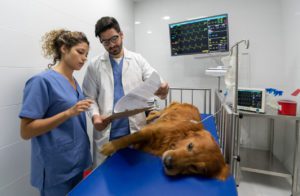5 Signs Your Dog is Having An Emergency in Pasadena, TX
Most people would easily recognize many signs that a dog is suffering an emergency. When a dog has had a trauma such as an accident with a car, or is bleeding profusely, or cannot gain their feet and remain standing, it’s pretty obvious the dog is in trouble.
But there are many incidents that are emergencies besides those. It’s important for dog owners to fully educate themselves about potential emergencies their canine friend can suffer.
Dog owners should not only learn about what could happen, but also about what to do if their dog has an emergency. Being unprepared can leave a dog owner in a panic when they need to remain cool so they can access the situation and know what to do to help their dog.
If your dog is suffering an emergency, other than in cases of heatstroke or heat stress, keep your dog warm. And do your best to keep your dog as still as possible. Call your veterinarian’s office and follow their specific instructions.
Dogs depend on their owners to know when to take swift action when needed. Knowing the difference between something that is a minor problem and a life threatening event will go a long way to keeping pets safe and healthy.

Unless you have a very small dog, get someone to help you move a sick or injured dog if at all possible. In most cases, you’ll want to get your injured dog to the veterinarian’s office as soon as possible.
Always remember to maintain your own safety first. An injured, frightened dog, can react in an unexpected manner. Even the gentlest dog that is in serious pain and is frightened, can bite. It’s an instinctive, survival response. Take care of yourself so that you can help your dog when he needs you the very most.
This article will explore 5 signs that all dog owners need to recognize as an emergency. When you know your dog is in danger, you can take the necessary steps to save his life.
5 Signs of a Dog Emergency
Dog Vomiting
Dogs can vomit for many reasons. Often it’s nothing to be overly concerned about. When a dog vomits once, getting rid of whatever upset his stomach, it’s usually not something to cause concern. But when there are repeated bouts of vomiting, it’s a sign that something’s wrong.
Vomiting can stem from many causes, and your vet will have to determine what is behind your dog’s sudden illness. There are things you can do to help your veterinarian diagnose the cause.
First, try to determine if your dog raided the kitchen. It’s possible he just snagged something from the trash or something left out that didn’t agree with his digestive system. In which case, your dog will be fine once his stomach settles down.
Though it’s possible that he could have found something in the kitchen that’s toxic. If you discover your dog got into chocolate, onions, or grapes, you need to call your vet immediately. These items are toxic and you need to take their consumption seriously.
It’s important to know the foods that can harm your dog and make sure to secure them where a snooping dog won’t find them and possibly consume them.

If your dog’s vomit is bloody, (there may be blood in the stool as well) this can indicate an obstruction in the digestive tract. This could be anything from balled up string or a sock, to a plastic toy. Internal organs can become damaged when a foreign object is lodged and unable to pass through the dog’s system. This is an immediate emergency and your veterinarian will need to determine the best method to remove the item.
Vomiting could also be caused from a bacterial or viral infection. Parvovirus is once such virus that is a huge threat to puppies. Several chronic conditions and some kinds of cancer can also cause vomiting.
In any case, repeated bouts of vomiting is a clear indicator that something is seriously wrong with your dog. Contact your veterinarian and do as you’re instructed.
Dog Bloating
If you notice a bulge behind your dog’s ribcage, this distention (bloat) is caused by gas. Gastric dilation, and volvulus (GDV) is an emergency. Early stages can include repeated but unsuccessful attempts to vomit.
It is possible for the stomach to twist and cause a volvulus. When this happens, the entrance and exit of the stomach is blocked. The stomach will swell even more due to gas being blocked inside the stomach. Additionally, the blood supply is cut off to the stomach and spleen.
Other signs include:
- Restlessness
- Panting
- Salivation
- Pale gums
- Lethargy
Shock will then lead to collapse. The dog will not survive without emergency veterinary care.

Respiratory Distress
Any time a dog is having trouble breathing, it’s an emergency situation that requires immediate veterinary care. Respiratory distress can be caused by many things.
Signs of distress include:
- Gagging or gasping for breath
- Gums can appear gray, blue, or purple
- Always remember, a dog that has difficulty breathing may panic. A panicked dog might bite out of fear. Be very cautious with a panicked dog.
Call your veterinarian immediately and follow any instructions you’re given.

Change In Dog Body Temperature
Normal body temperature for a dog is between 100.5 and 102.5 degrees Fahrenheit. Anytime a dog’s body temperature dips below 99 degrees, indicating hypothermia or goes above 104 degrees in an overheating situation, the dog is experiencing a serious medical event.
When a dog’s temperature drops to 99 – 98 degrees Fahrenheit, hypothermia is setting in. If a dog progresses to severe hypothermia, it will eventually go into shock, organ failure, and coma, death will follow.
On the other hand, when a dog overheats and its temperature continues to rise and reaches 106 degrees Fahrenheit or above, your dog is suffering from heat stroke. Anytime a dog’s temperature goes above 104 degrees, you need to seek veterinary attention. Heatstroke can quickly lead to a dog dying.
Seizures
Any pet experiencing a seizure is terrifying for an owner. When a dog has a seizure, it stems from abnormal brain activity. There is altered or a complete loss of consciousness. And the worst are violent, long lasting episodes.
Never put your hand in the dog’s mouth, it will not swallow its tongue, but you may be severely bitten during the event.
There are several causes for seizures in dogs and there are three types of seizures including:
- Focal (partial), only a part of the brain and part of the body is affected, but usually progresses over the dog’s life time to generalized seizures.
- Generalized (grand mal), affect both sides of the brain and entire body
- Focal with secondary generalization
Some causes include:
- Brain tumors
- Toxins
- Genetic problems
- Trauma
- Organ issues
- Unknown reasons

Before a seizure, your dog may appear dazed or frightened. He may come to you for attention and reassurance.
Many times seizures will strike when the dog has gone to sleep or is resting quietly and they typically last between 30 and 90 seconds.
During the event, he will become stiff, his legs will move about, he will clench his jaw and salivate, he will vocalize, and he may not be able to control urination and defecation.
Once the event ends, your dog might recover quickly or it may take up to 24 hours for him to return to normal. During this time he may be confused and wander aimlessly. He may have visual problems, and he may have an increased thirst and/or appetite.
Contact your veterinarian and follow their guidance for any future events and needed medications to maintain your dog’s health.
Conclusion
When your dog’s involved in an emergency, seek appropriate medical care as soon as possible. If your dog suffers any of these medical emergencies, you will want to follow your veterinarian’s advice and instructions.
When pets are in distress, it can be difficult to remain calm and act rationally, but that’s when your pet needs you to remain cool and be able to assess the situation and take the correct steps to help them.
An unexpected event can be the most difficult for dogs and owners alike. Handling it in a calm manner will help your pet mentally as well as physically. Talking to your dog in a soothing tone verses in a frantic manner will help calm him when he may need to remain still.
As dog owners, it’s our responsibility to learn as much as possible about our dog’s breed, any genetic issues, and any past medical events he may have experienced. Information is your best bet for keeping your dog healthy and happy for all the years of his life.
Educating yourself about any known medical issues your dog has may save his life. Our canine friends depend on us to help them live their best life every day.
Knowing your dog’s history and learning about things that could happen and what to do in emergencies will go a long way toward keeping your dog safe and healthy.
Recent Posts
About Spencer Animal Hospital
Spencer Animal Hospital is a staple of the Pasadena community. Our veterinarians and staff have been providing high-quality, compassionate veterinary medicine since 1974. As a full-service veterinarian in Pasadena, TX, we serve dogs and cats with expert, personalized, affordable care.



